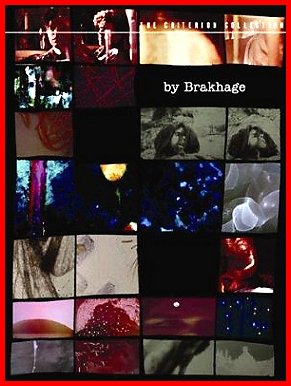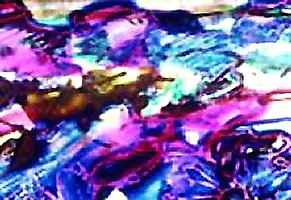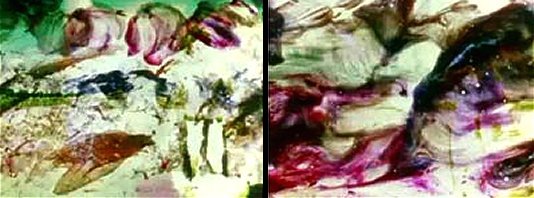|
|
| Sei in: Cinema e Medioevo ® Indice alfabetico dei film |
The Dante Quartet
1987, regia di Stan Brakhage

Scheda: Nazione: USA - Distribuzione: Canyon Cinema, The Criterion Collection - Effetti speciali: Dan Yanosky - Formato: Color, corto - Durata: 6'.



![]() Trama e commenti:
frameonline.it
-
02.unibg.it
-
torinofilmfest.it: «L'origine [di
The Dante Quartet] risale alle scuole superiori. Il mio professore di inglese
disse che avrei dovuto studiare Dante e contemporaneamente La montagna
incantata di Thomas Mann. Ragazzi, era veramente troppo. Il fatto è che mi
spinse verso la ricerca di una vita: così ho letto quasi tutte le traduzione
reperibili in lingua inglese della Divina Commedia di Dante. E ci ho
convissuto un giorno dopo laltro. Poi venne un momento in cui, improvvisamente,
non riuscivo più a trattare il linguaggio. Non potevo più leggere alcuna
traduzione della Divina Commedia. E d'un tratto capii che l'avevo
continuamente negli occhi, che avevo una visione dell'Inferno e,
inevitabilmente, anche una via d'uscita, una specie di trampolino nel pensiero.
Chiudere gli occhi e pensare a ciò che stavo vedendo, a come uscirne. E anche
un'espiazione, perché potevo passare attraverso le fasi di una purificazione
dell'io, in un tentativo di diventare puro, libero dalle visioni spettrali. E
poi c'era la cosa più vicina al Paradiso a cui avrei potuto aspirare, che chiamo
«l'esistenza è musica». Ed era tutto sempre nei miei occhi e si ripresentava
negli anni. È bello che io possieda il linguaggio, ma anche che ne abbia un
corollario visivo. Questa però è una storia, perché si tratta di quattro fasi
cruciali in una piccola narrazione che penso sia fondamentale capire per sentire
il film fino alla fine» (S. Brakhage, intervistato da Bruce Kawin
nell'aprile 2002).
Trama e commenti:
frameonline.it
-
02.unibg.it
-
torinofilmfest.it: «L'origine [di
The Dante Quartet] risale alle scuole superiori. Il mio professore di inglese
disse che avrei dovuto studiare Dante e contemporaneamente La montagna
incantata di Thomas Mann. Ragazzi, era veramente troppo. Il fatto è che mi
spinse verso la ricerca di una vita: così ho letto quasi tutte le traduzione
reperibili in lingua inglese della Divina Commedia di Dante. E ci ho
convissuto un giorno dopo laltro. Poi venne un momento in cui, improvvisamente,
non riuscivo più a trattare il linguaggio. Non potevo più leggere alcuna
traduzione della Divina Commedia. E d'un tratto capii che l'avevo
continuamente negli occhi, che avevo una visione dell'Inferno e,
inevitabilmente, anche una via d'uscita, una specie di trampolino nel pensiero.
Chiudere gli occhi e pensare a ciò che stavo vedendo, a come uscirne. E anche
un'espiazione, perché potevo passare attraverso le fasi di una purificazione
dell'io, in un tentativo di diventare puro, libero dalle visioni spettrali. E
poi c'era la cosa più vicina al Paradiso a cui avrei potuto aspirare, che chiamo
«l'esistenza è musica». Ed era tutto sempre nei miei occhi e si ripresentava
negli anni. È bello che io possieda il linguaggio, ma anche che ne abbia un
corollario visivo. Questa però è una storia, perché si tratta di quattro fasi
cruciali in una piccola narrazione che penso sia fondamentale capire per sentire
il film fino alla fine» (S. Brakhage, intervistato da Bruce Kawin
nell'aprile 2002).
![]() Plot Summary, Synopsis, Review: IMDb
-
seul-le-cinema.blogspot.com
-
mitternachtskino.de
-
onfilm.chicagoreader.com
-
archive.sensesofcinema.com:
«Painstakingly crafted over six years (an unusually long period for the
prolific Brakhage), The Dante Quartet is a palimpsest composed of
fragments of footage originally shot on 35mm, 70mm and IMAX stock that have been
layered with drips and washes of colour, scratches and graphic patterns. (The
film itself has been distributed on both 16mm and 35mm, though never in the
large IMAX format that Brakhage initially envisaged as ideal for a work of
cathedral-like dimensions.) The finished film retains some of the material marks
of these “origins”: the size and dimensions of the image change at several
points, and remnants of the original “found” footage (including images from a
worn 70mm print of Billy Wilder's Irma la Douce [1963]) rise to the
“surface” of the image. ... The Dante Quartet is in fact the end result
of Brakhage's almost lifelong fascination with The Divine Comedy. It is a
brief but spectacular filmic attempt to find a visual equivalent or rhyme for
the four stages of the ascent from hell depicted by Dante: divided into “Hell
Itself,” “Hell Spit Flexion,” “Purgation,” and “Existence is Song.” For Brakhage,
this visualisation is achieved by “bringing down to earth Dante's vision,
inspired by what's on either side of one's nose and right before the eyes: a
movie that reflects the nervous system's basic sense of being.” Thus, his vision
of Dante is experiential, grounded in the transformative realities of earthly
existence; for Brakhage “heaven” or “god” is to be found in the physical reality
or materiality of the world. In many respects the details of a progression or
transformation are difficult to fathom from the finished seven-minute film – all
of which has a luminous visual beauty. In the third and fourth parts, the range
of colours and the luminous quality of light come to the fore, with a shift from
the smudged tones of the first part to a more visionary, cosmic set of images (as
often in Brakhage's work, there is a simultaneous movement inwards to a
subjective vision and outwards into the universe). The increasing
representational content of these final sections – including the lava of a
volcano and the horizon of the planet – signifies a return to the earth, to
non sequitur images or cleansing visions that cannot be contained within any
single representational chain or system. Similarly, the snatches of text that
appear four times suggest the world of Dante's writing (even if the final
quotation, “existence is song,” is from Rilke) without ever really anchoring the
film's “representational” realm. The text dances into the film, introducing each
“section”, but it always seems incomplete, quickly expunged by the patterns and
swabs of painted colour (is it colour or symbol, paint or film?)...» (Adrian
Danks).
Plot Summary, Synopsis, Review: IMDb
-
seul-le-cinema.blogspot.com
-
mitternachtskino.de
-
onfilm.chicagoreader.com
-
archive.sensesofcinema.com:
«Painstakingly crafted over six years (an unusually long period for the
prolific Brakhage), The Dante Quartet is a palimpsest composed of
fragments of footage originally shot on 35mm, 70mm and IMAX stock that have been
layered with drips and washes of colour, scratches and graphic patterns. (The
film itself has been distributed on both 16mm and 35mm, though never in the
large IMAX format that Brakhage initially envisaged as ideal for a work of
cathedral-like dimensions.) The finished film retains some of the material marks
of these “origins”: the size and dimensions of the image change at several
points, and remnants of the original “found” footage (including images from a
worn 70mm print of Billy Wilder's Irma la Douce [1963]) rise to the
“surface” of the image. ... The Dante Quartet is in fact the end result
of Brakhage's almost lifelong fascination with The Divine Comedy. It is a
brief but spectacular filmic attempt to find a visual equivalent or rhyme for
the four stages of the ascent from hell depicted by Dante: divided into “Hell
Itself,” “Hell Spit Flexion,” “Purgation,” and “Existence is Song.” For Brakhage,
this visualisation is achieved by “bringing down to earth Dante's vision,
inspired by what's on either side of one's nose and right before the eyes: a
movie that reflects the nervous system's basic sense of being.” Thus, his vision
of Dante is experiential, grounded in the transformative realities of earthly
existence; for Brakhage “heaven” or “god” is to be found in the physical reality
or materiality of the world. In many respects the details of a progression or
transformation are difficult to fathom from the finished seven-minute film – all
of which has a luminous visual beauty. In the third and fourth parts, the range
of colours and the luminous quality of light come to the fore, with a shift from
the smudged tones of the first part to a more visionary, cosmic set of images (as
often in Brakhage's work, there is a simultaneous movement inwards to a
subjective vision and outwards into the universe). The increasing
representational content of these final sections – including the lava of a
volcano and the horizon of the planet – signifies a return to the earth, to
non sequitur images or cleansing visions that cannot be contained within any
single representational chain or system. Similarly, the snatches of text that
appear four times suggest the world of Dante's writing (even if the final
quotation, “existence is song,” is from Rilke) without ever really anchoring the
film's “representational” realm. The text dances into the film, introducing each
“section”, but it always seems incomplete, quickly expunged by the patterns and
swabs of painted colour (is it colour or symbol, paint or film?)...» (Adrian
Danks).